The first Italian Dreadnought
With limited industrial capabilities compared to the UK, Italy could not compete in numbers or construction time, when the first world war broke out. Therefore only six of them were built, a “prototype”, the Dante Alighieri, and two series, the Cesare and Cavour, five ships total, partially completed during the war. And the great irony was the “invention” of the monocaliber battleship concept could be attributed to the Italian naval engineer Vittorio Cuniberti, under the ministry of G. Bettolo in 1899.
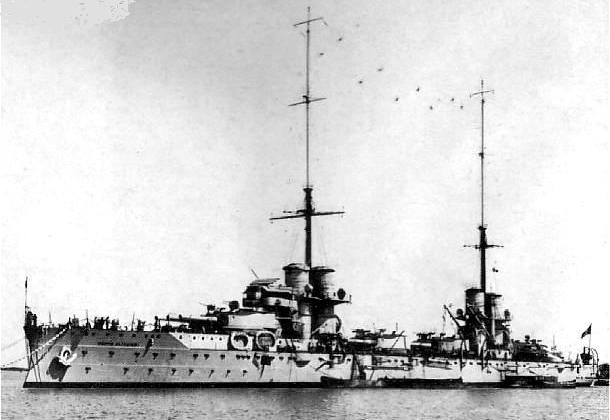
By publishing in Jane’s 1903 his “monocaliber armoured cruiser”, he had presumably quite an impact on naval staffs of the time. Possibly also British admiral J. Fisher. Italy however for budgetary reasons had to compromise and left to UK the privilege to test the concept. Therefore the Dante Alighieri came a bit later, but it was very innovative nonetheless, introducing triple turrets for the first time, a configuration which became standard on fast battleships of the interwar generation. That’s why the Italian dreadnought would remain a landmark in naval history.
Development of the Italian Dreadnought Battleships
V. Cuniberti ideas
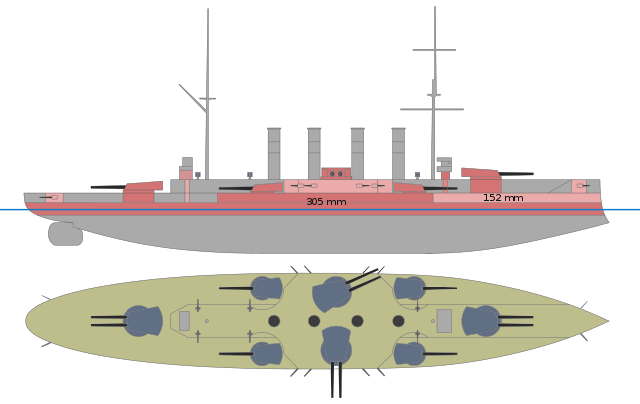
He would remain in history as the man advocating a concept known as the “all-big-gun” fighting ship. Designing a 8-in armed ‘battleship’ already in 1899, the concept was 22 knots, protected by 6 in (150 mm) thick belt armor. However it is still not clear if the idea was initiated by minister of the Navy Giovanni Bettolo under the Pelloux II government, or if Bettolo was informed of Cuniberti’s idea and decided to offer him a chance to submit his design for possible approval (which was not in his hands, but the parliament). Whatever the case, the parliament rejected the design as too costly, and Cuniberti had to compromise when he sarted the design in 1901-1902 of the Regina Elena.
The latter were groundbreaking though, they were fast and have a considerable secondary armament, and can be considered as “semi-dreadnoughts” or a stopgap solution, in between armored cruisers and battleships, or pre-dreadnoughts and proper dreadnoughts. His “colossus” of the seas as he put it, was to armed by the largest available caliber of the time, 12-in, but not a 12-in protection. She was indeed to be protected only against seocndary caliber. The reason was to keep the ship light in order to be fast. The principle was simple: With an all-big battery and superior speed, Cuniberti ‘colossus’ was to be able to choose her entry into the duel, use saturation fire to quickly overwhelm the enemy and retire as fast, whereas taking one hit by the enemy was not that of grave consequences.
Of course this view was made in regard of the poor accuracy of the time, modern rangefinder and mechanical calculators has not been invented yet, and WW1 showed sometimes a single lucky hit in plunging fire could destroy a ship completely. In his design also, secondary armament was superfluitous. His ship could only carry the usual QF guns dedicated to enemy TBs. Cuniberti’s ‘colossus’ was also capable on paper of engulfing an enemy ship with a 12-in volley before going to the next in line, down the last. A single ship which was proved capable of eliminating an entire fleet. For the time, this was nothing but revolutionary.
After his proposal was rejected Cuniberti was granted permission by his government to write the article for Jane’s Fighting Ships. Two years after the Battle of Tsushima vindicated his ideas. But the decision of Jackie Fisher was not clearly motivated by Cuniberti’s article. In his memoirs the dreadnought design was not attributed to the Italian Engineer anyway. Instead, Fisher perhaps crystallized a growing opinion of the time, also shared in japan and the USA. “Some ideas has many fathers”.
In the USA for example, the General Board received many proposals already since 1900, including monocaliber ships or mixed designs. In Japan, IJN Satsuma was to be originally designed with a dozen 12-inch (305 mm) guns, rejected at first because of budgetary constraints and the squarcity of this caliber at home. Nevertheless, Cuniberti was the first to publish the concept formally. Cuniberti would have his “revenge” by influencing John Brown and Co. design of the Russian Gangut, which is strikingly similar to the Dante Alighieri.
The last pre-dreadnought: Regina Elena class
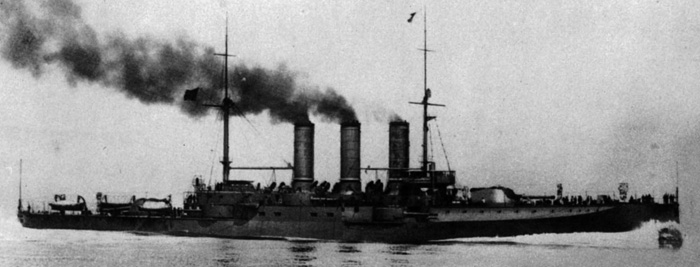
This last design was very much influenced already by Cuniberti’s ideas. It was a compromise; with two main gun 12-in turrets and six twin 8-in turrets. The latter packed quite a punch compared to the standard secondary artillery of the time, around 5 to 6 in, and went down straight to quick firing light guns. There were the fastest pre-dreadnoughts on record, certainly also among the best armed, and the reason of the adoption of a 8-in rather than a 10-in (254 mm) caliber was to avoid misidentification of the water plumes by the fire control system observer. In addition the odd choice of singe 305mm turrets was not random. There were at least four reasons behind it:
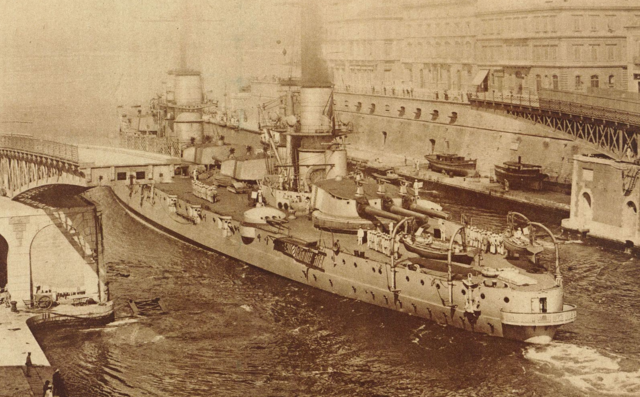
Dante Alighieri in Taranto during ww1
-They were lighter than twin turrets, and the ship needed to be light
-This allowed to place them further apart of the superstructure, giving them an excellent 300° field of fire
-This lessened the structural fatigue of the hull, avoiding extra bracing and this making it lighter
-Accuracy was not improved by having twin guns, allowing dispersion when shooting in concert.
However one might remember thay the monocaliber project of Cuniberti, published in jane’s in 1903 and refused to him, was comprising a full twelve 12-in battery. So only because of budget constraints the first dreadnought could have been Italian.
Eventually these four battleships were actively deployed from the Italo-Turkish war to 1918, but served only a few years afterwards, being discarded in the 1920s because of treaty limitations. They would remain as stopgap solutions but tested some concepts.
Development of the Dante Alighieri
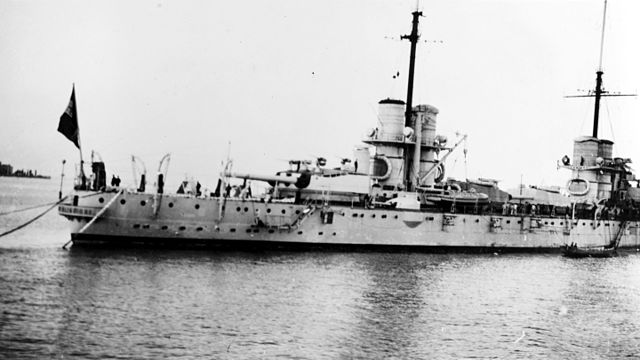
The decision to swap from the pre-dreadnought to the dreadnought had several causes: First of course, the launch of the HMS Dreadnought in 1906, a ship for which the Italians has no response. Second, the fear that Austria-Hungary would start such ships, which was likely in 1909. In fact the Italian first dreadnought was laid down and launched before the Austro-Hungarian dreadnought Viribus Unitis. Third, the scare was enough to raise the necessary budget, contrary to the previous class and V. Cuniberti being rebuffed.
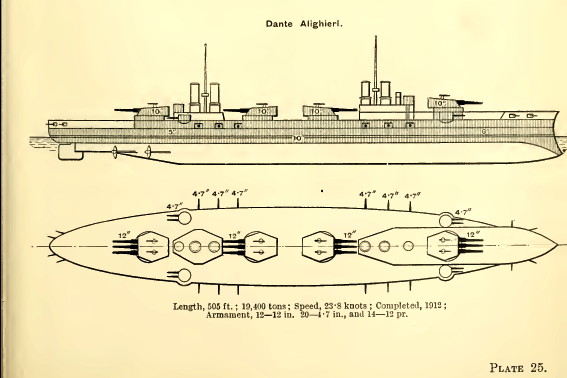
The project’s technical aspects were entrusted to Edoardo Masdea (Naples, 23 July 1849 – Rome, 12 May 1910), an Italian politician and general but first and foremost one of the most revered engineer in the Navy, earning the rank of general of naval engineering. He already designed several naval classes of the Regia Marina such as the Vettor Pisani under the direction of Benedetto Brin and by himself latter the Giuseppe Garibaldi class (probably the best Italian export success of the time) and the cruisers Pisa and San Giorgio. He was indeed well placed to take charge of the first true monocaliber design of the Regia Marina. Design work started in 1906.
General Giuseppe Rota, first director of the La Spezia Naval directorate closely collaborated on the project. The main armament was to be made of twelve 305 mm guns but their was some debate over the best configuration. The Italians observed (and cristicized) the British solution which sacrificed one turret for the broadside. They eventually came with the only one which could maximize it and preserved the integrity of the hull, making turrets large enough to house three guns instead of two. The repartition of the turrets was simple enough however.
They could have chosen to place them in superfiring pairs but this was a risky move due to their weight (and stability issues). There was already a move towards high speed while sacrificing some armour -therefore hull strenght- but no constraints in shipyard’s basin size. On the Autro-Hungarian size, the solution of tripl turrets, quite radical by that time, was also chosen, but in superfiring turrets, because of the constraints of the shipyards involved, which restrained the lenght of the hull. There was no other choice. In 1909, this was the solution chosen by the Russians as well, which too believed in the broadside and dismissed the initial superfiring turret solution of the British proposal. Their ship too, was lightly armored and lower, well-spaced turrets guaranteed better strength and stability. But it also imposed radically reduced superstructure in order to allow traverse angles up to 200° and more for the inner turrets.
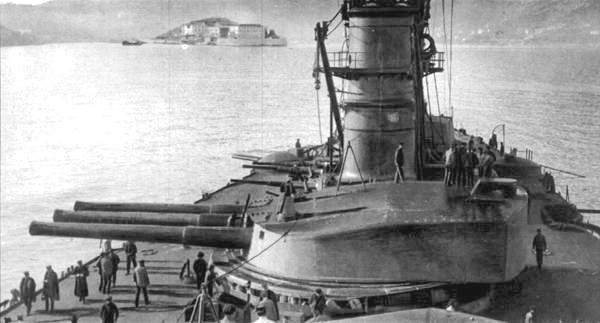
Dante Alighieri’s main turret
After the final design was approved, the ship was ordered to Castellammare naval yard, laid down on 6 June 1909.
About the name
Although it was the first and only ship of the Regia Marina and of the Italian Navy ever named after the great poet, in the thirties four destroyers of the Alfredo Oriani class were named after poets as well.
The motto of the ship “With the soul that wins every battle” was taken from verse 53 of Canto XXIV of the Inferno.
Design of the Dante Alighieri
The hull was relatively classic in regard of other Italian designs of the time. The battleship displaced 19,552 long tons (19,866 t) at normal load, and 21,600 long tons (21,900 t) deeply loaded, with a length of 168.1 m (551 ft 6 in) overall with a curved bow ending in a moderate spur ram. The hull was 26.6 m (87 ft 3 in) large so relatively narrow compared to ther designs, helping with top speed, and the draught 8.8 m (28 ft 10 in), forced by the considerable powerplant. The turrets were placed along the hull at regular intervals, one on the front forecastle, two in the center, opposing one another or heading the same direction, and a fourth aft. Two large recess were made along the forecastle to maximize forward-firing angles for the main armament and acomodate the two twin-turrets which were another innovation of the type.
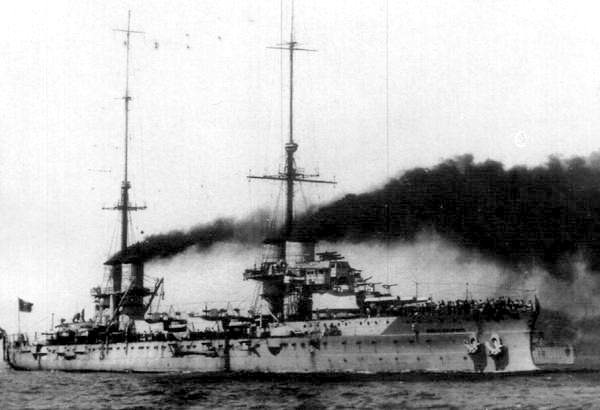
Dante Alighieri at full speed during sea trials
Powerplant of the Dante Alighieri
Speed was to be the main focus of this battleship, like the previous Regina Elena, the fastest pre-dreadnought of their time. At first 23 knots were planned but the new mixed-heating and arrangement of the ship has not yet been tested and bring back it in reality to 22 knots. This was still two knots better than the Tegethoff class in construction (also because of size constraints), and one knot better than the HMS Dreadnought, but the Gangut made was planned for more than 24 knots.
Four propeller shafts were driven by Parsons steam turbines. Their steam was procured bt 23 Blechynden mixed-firing water-tube boilers: Seven burned oil and seventeen burned oil and coal. They were widely separated in two compartments truncated into two funnels pairs above. The turbines were placed between the two center axial turrets for stability.
Top speed as designed wa 23 knots (43 km/h; 26 mph) from 35,000 shaft horsepower (26,000 kW). But sea trials failed to deliver the designed speed, topping at 22.83 knots (42.28 km/h; 26.27 mph) for 32,190 shp (24,000 kW) horsepower. 3,000 tonnes (2,953 long tons) of coal were carried, plus oil, enough for 4,800 nautical miles (8,900 km; 5,500 mi) at cruise speed, reduced to 1,000 nmi at top speed.
Armament
Main Battery: The dozen 46-cal. 305-millimeter (12-in) guns in triple-gun turrets were in the axis. It seems the Russian configuration has been influenced by the Italians, but nothing prove it and the configuration was chosen for their own reasons. In addition the center turrets were facing at each other on the Russian design.
Historian Giorgio Giorgerini precised their shell was 452-kilogram (996 lb) in armor-piercing (AP) default configuration at the rate of one per minute with a muzzle velocity of 840 metres/second (2,800 ft/s). Maximal range was about 24,000 meters (26,000 yd).
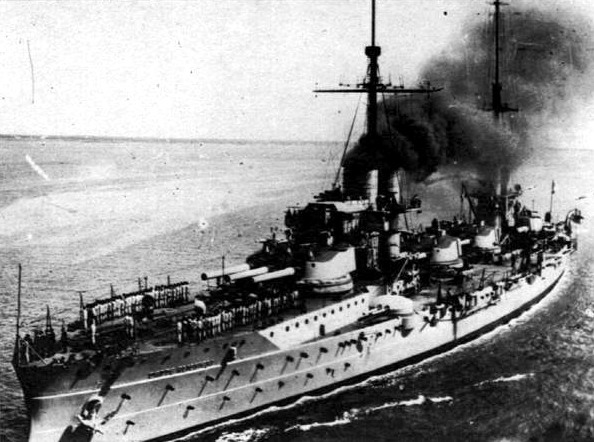
Battleships’ crew review in 1915
Secondary Battery: Twenty 120-millimeter/50 (4.7 in) guns were placed in barbettes along the hull and four twin turrets. They were placed abreast the forward and aft main gun turrets. The remaining 12 barbettes guns were placed in casemates at the prow, bow (four each) and side, along the two center turrets. The forecastle was recessed enough to allow these barbettes to fire forward.
Depress of these mounts was −10 degrees, elevation +15 degrees; Rate of fire was six shots a minute. Their projectile was a 22.1-kilogram (49 lb) HE shell, with a muzzle velocity of 850 meters per second (2,800 ft/s) at 12,000 yards (11,000 m) maximal range, about half the main guns. There were disagreement between sources, and the guns could have been 40 caliber at the beginning, replaced in 1915 by 50-calibers.
Tertiary Battery:
The usual complement of QF light guns against torpedo boats consisted of thirteen 50-caliber 76 mm (3.0 in) mounted on the turret tops. Range was the same 11,000 m than the secondary guns and elevation as well. The rate of fire was 10 rounds per minute. Their projectile was a 6-kilogram (13 lb) AP shell leaving the muzzle at 815 meters per second (2,670 ft/s) at 10,000 yards (9,100 m).
For close-quarter in addition, the Dante Alighieri was armed with three submerged 45-centimeter (18 in) torpedo tubes, broadside and stern.
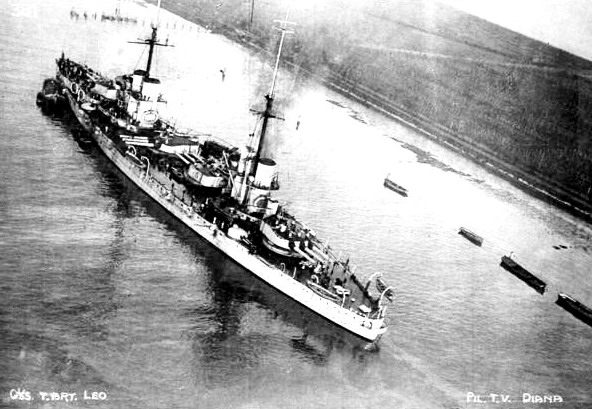
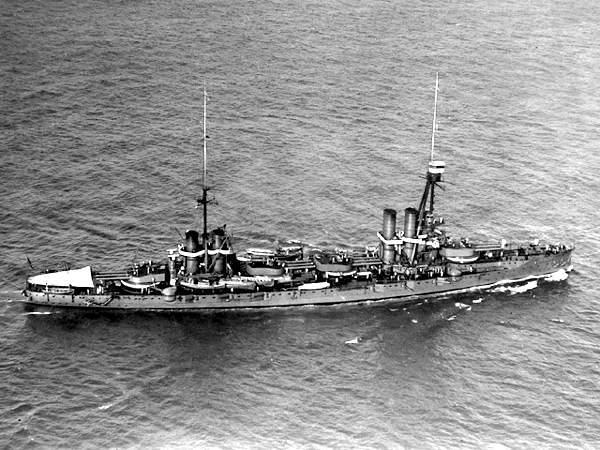
Overview of the ship
Protection
This was the “poor child” of the design, comparatively to British and German ships in particular. There was a complete waterline armor belt, 254 mm (10.0 in) at the thickest. The armored deck was however only 38 mm (1.5 in) thick, a grave error because of plunging fire. The main turrets were protected 254 mm thick also on their front and sides, and the secondary turrets and casemates were protected only by 98 mm (3.9 in). This was substandard compared to the calibers adopted. The conning tower at last was given 305 mm (12.0 in) thick walls, able to sustain 12-in fire. This was still better than the Gangut class, which CT was 254 mm and the rest ranged from 225 mm (belt) down to 203 mm (main turrets).
The Dante Alighieri in action
The Italian battleship, launched at Castellammare di Stabia on 20 August 1910, was completed on 15 January 1913. She missed therefore the Italo-Turkish war. She spend the only year prior to the war training, showing the Regia Marina how to handle this new generation of battleship. The Dante was once tested with floatplanes for observation, of the Curtiss model, prior to the war. By May 1915, Dante Alighieri was the flagship of the 1st Battle Squadron at Taranto. She remained there, mostly inactive, until 1916, but joined the Southern Adriatic and Ionian Sea forces, under command of vice-admiral Paolo Thaon di Revel. She was tasked to intercept a possible sortie of Austro-Hungarian ships from Cattaro. This was feared in particular during the allied shelling of Durazzo on 2 October 1918.
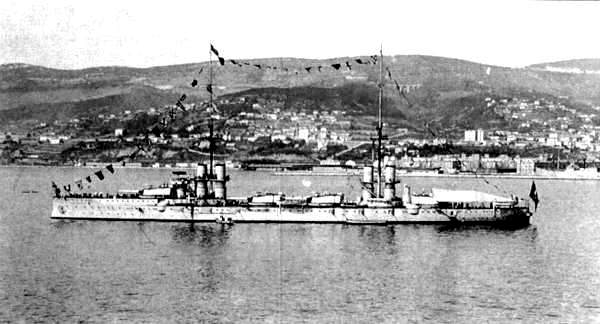
The Dante Alighieri in Trieste, 1918
The war ended quietly for the battleship, which had never fired a shot in anger. By 1922, King Victor Emmanuel III was bring to a conference in Genoa with officials. The next year, the ship was modernized. It was hoped to keep her up to date. Her forward mast was replaced by a sturdier tripod, with a new rangefinder and fire control system on top. To reduced smke interference her forward funnels were reduced. For observation her forward turret also received an aircraft flying-off platform on Turret No. 3.
She tested in 1924 the new rangefinder in various configurations. The system allowed a range up to 26,000 meters (28,000 yd). The tripod and configuration was retained later for the Conte di Cavour-class battleships. She also transported this year Benito Mussolini to Palermo. However, the dire state of Italian economy forced drastic cuts, including in the Navy. Admiral Sechi decided to scrap Dante Alighieri and the Leonardo Da Vinci, recently foundered but salvaged and ready for repairs. The budget savings would serve to modernize the four existing, more recent dreadnoughts in a radical way. We can only guess the appearance of the Dante Alighieri if modernized the same way (see the drawing below). After being mothballed in from 1926, she was stricken and scrapped in July 1928, after a career of only 15 years for the prototype of Italian dreadnoughts.
Dante Alighieri specifications 1940 |
|
| Dimensions | 168.1 x 26.6 x 8.8m |
| Displacement | 19,552 long tons (19,866 t), 21,600 long tons (21,900 t) FL |
| Crew | 981 |
| Propulsion | 4 shafts steam turbines, 23 Yarrow WT mixed boilers, 32,190 hp |
| Speed | 22 knots (41 km/h; 25 mph) |
| Range | 4,800 nmi (8,900 km; 5,500 mi) at 10 knots (19 km/h; 12 mph) |
| Armament | 12 x 305 mm/50 (4×3), 20 x 120 mm/50, 13 x 76 mm QF, 3 x 450 mm TTs. |
| Armor | Decks 38 mm, gun turrets 254 mm, belt 254 mm, CT 305 mm. |
Sources/Read More
Gardiner, Gray, Randal, eds. (1984). Conway’s All the World’s Fighting Ships: 1906–1921.
Cernuschi, Enrico; O’Hara, Vincent (2007). “Search for a Flattop: The Italian Navy and the Aircraft Carrier 1907–2007”. Conway.
Fink, Carole (February 1986). “Italy and the Genoa Conference of 1922”. The International History Review.
Friedman, Norman (2008). Naval Firepower: Battleship Guns and Gunnery in the Dreadnought Era.
Giorgerini, Giorgio (1980). “The Cavour & Duilio Class Battleships”. In Roberts, John (ed.). Conway Maritime Press.
Goldstein, Erik; Maurer, John H. (1994). The Washington Conference, 1921–22
Halpern, Paul S. (1994). A Naval History of World War I.
Hore, Peter (2005). Battleships.
Preston, Antony (1972). Battleships of World War I: An Illustrated Encyclopedia
Sandler, Stanley (2004). Battleships: An Illustrated History of their Impact. Weapons and Warfare.
Illustration of the Dante Alighieri in WW1 by the author (scale 1/730)


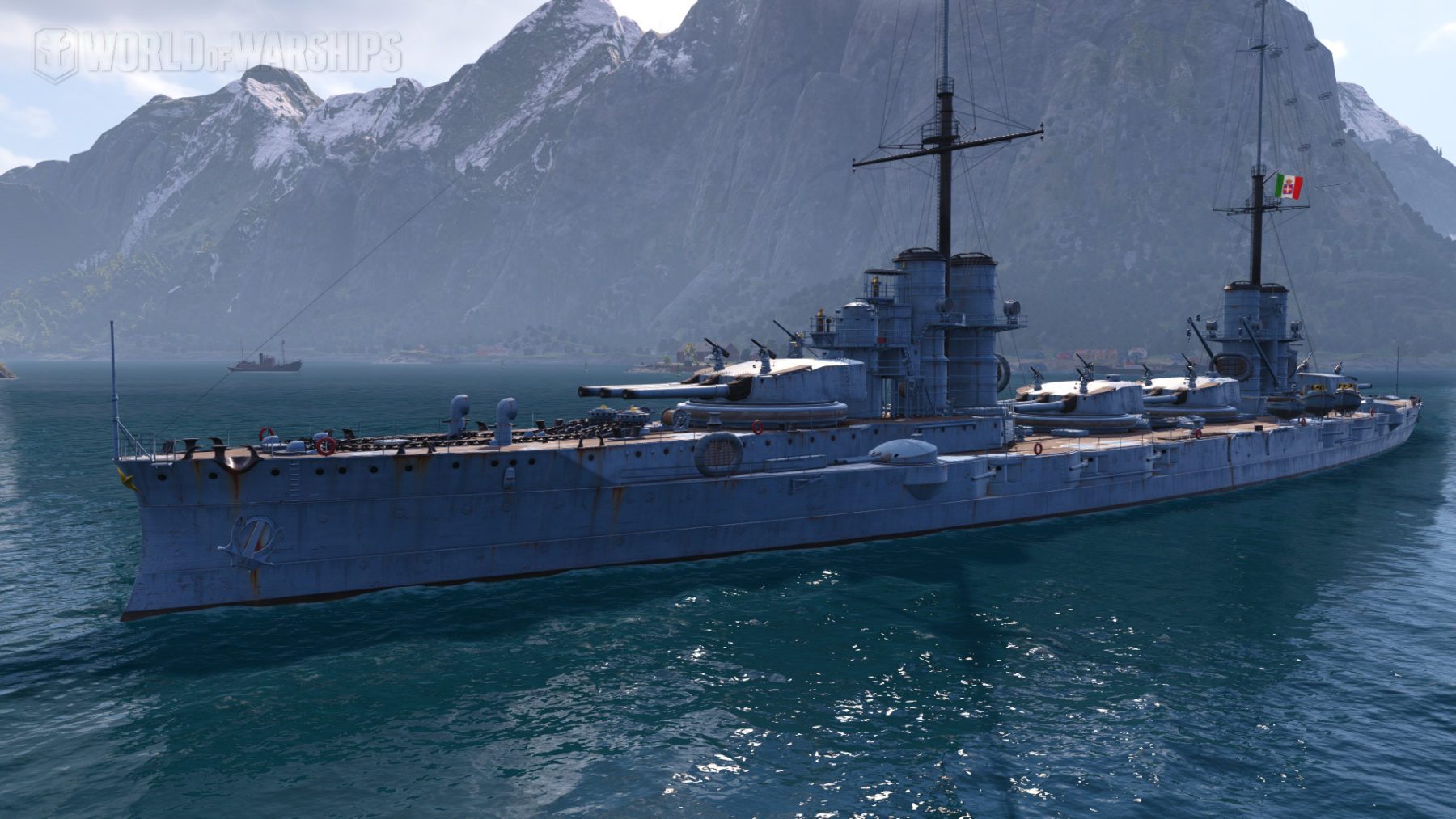

 Latest Facebook Entry -
Latest Facebook Entry -  X(Tweeter) Naval Encyclopedia's deck archive
X(Tweeter) Naval Encyclopedia's deck archive Instagram (@navalencyc)
Instagram (@navalencyc)





 French Navy
French Navy Royal Navy
Royal Navy Russian Navy
Russian Navy Armada Espanola
Armada Espanola Austrian Navy
Austrian Navy K.u.K. Kriegsmarine
K.u.K. Kriegsmarine Dansk Marine
Dansk Marine Nautiko Hellenon
Nautiko Hellenon Koninklije Marine 1870
Koninklije Marine 1870 Marinha do Brasil
Marinha do Brasil Osmanlı Donanması
Osmanlı Donanması Marina Do Peru
Marina Do Peru Marinha do Portugal
Marinha do Portugal Regia Marina 1870
Regia Marina 1870 Nihhon Kaigun 1870
Nihhon Kaigun 1870 Preußische Marine 1870
Preußische Marine 1870 Russkiy Flot 1870
Russkiy Flot 1870 Svenska marinen
Svenska marinen Søværnet
Søværnet Union Navy
Union Navy Confederate Navy
Confederate Navy Armada de Argentina
Armada de Argentina Imperial Chinese Navy
Imperial Chinese Navy Marinha do Portugal
Marinha do Portugal Mexico
Mexico Kaiserliche Marine
Kaiserliche Marine 1898 US Navy
1898 US Navy Sovietskiy Flot
Sovietskiy Flot Royal Canadian Navy
Royal Canadian Navy Royal Australian Navy
Royal Australian Navy RNZN Fleet
RNZN Fleet Chinese Navy 1937
Chinese Navy 1937 Kriegsmarine
Kriegsmarine Chilean Navy
Chilean Navy Danish Navy
Danish Navy Finnish Navy
Finnish Navy Hellenic Navy
Hellenic Navy Polish Navy
Polish Navy Romanian Navy
Romanian Navy Turkish Navy
Turkish Navy Royal Yugoslav Navy
Royal Yugoslav Navy Royal Thai Navy
Royal Thai Navy Minor Navies
Minor Navies Albania
Albania Austria
Austria Belgium
Belgium Columbia
Columbia Costa Rica
Costa Rica Cuba
Cuba Czechoslovakia
Czechoslovakia Dominican Republic
Dominican Republic Haiti
Haiti Hungary
Hungary Honduras
Honduras Estonia
Estonia Iceland
Iceland Eire
Eire Equador
Equador Iran
Iran Iraq
Iraq Latvia
Latvia Liberia
Liberia Lithuania
Lithuania Mandchukuo
Mandchukuo Morocco
Morocco Nicaragua
Nicaragua Persia
Persia San Salvador
San Salvador Sarawak
Sarawak Uruguay
Uruguay Venezuela
Venezuela Zanzibar
Zanzibar Warsaw Pact Navies
Warsaw Pact Navies Bulgaria
Bulgaria Hungary
Hungary

 Bundesmarine
Bundesmarine Dutch Navy
Dutch Navy Hellenic Navy
Hellenic Navy Marina Militare
Marina Militare Yugoslav Navy
Yugoslav Navy Chinese Navy
Chinese Navy Indian Navy
Indian Navy Indonesian Navy
Indonesian Navy JMSDF
JMSDF North Korean Navy
North Korean Navy Pakistani Navy
Pakistani Navy Philippines Navy
Philippines Navy ROKN
ROKN Rep. of Singapore Navy
Rep. of Singapore Navy Taiwanese Navy
Taiwanese Navy IDF Navy
IDF Navy Saudi Navy
Saudi Navy Royal New Zealand Navy
Royal New Zealand Navy Egyptian Navy
Egyptian Navy South African Navy
South African Navy






























 Ukrainian Navy
Ukrainian Navy dbodesign
dbodesign
Thankyou for attention payed to the italian engeenering in the development of pre-dreadnoght and dreadnouht in the Italian Navy, by this exaustive study, enlarged to politics, economics, strategy and tactics in naval warfare
Thanks Antonio !